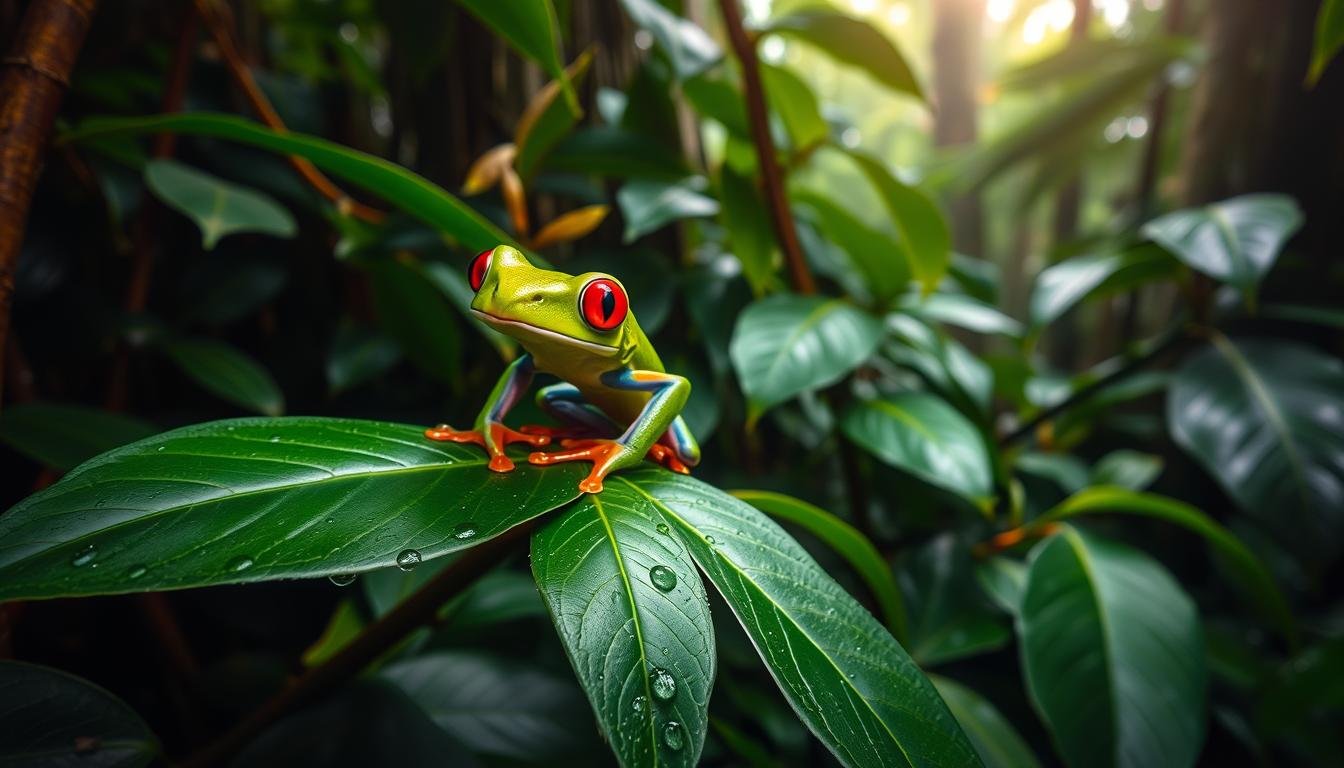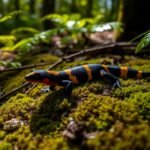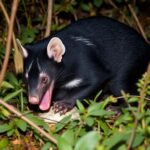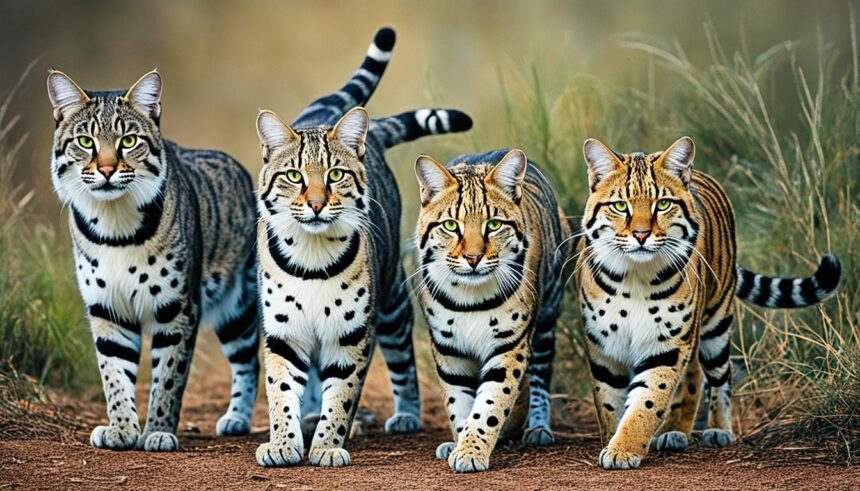The red-eyed tree frog (Agalychnis callidryas) is a well-known amphibian in Central and South America’s rainforests. It stands out with its bright green body, big red eyes, and blue-and-yellow sides. This frog is a key symbol in rainforest conservation.
Even though it looks striking, it’s not venomous. The IUCN lists it as Least Concern, but it still faces threats from habitat loss.
Understanding the Rainforest Red Eyed Tree Frog
The red-eyed tree frog, known as Agalychnis callidryas, is a unique amphibian. It belongs to the Phyllomedusidae family. These tree frogs live in the neotropical rainforest areas. They are found from southern Mexico to northern Colombia.
Scientific Classification and Taxonomy
The red-eyed tree frog is classified as follows:
- Class: Amphibia
- Order: Anura
- Family: Phyllomedusidae
- Genus: Agalychnis
- Species: Agalychnis callidryas
Physical Characteristics Overview
These tree frogs are quite small, growing 1.5 to 2.75 inches long. Females are usually a bit bigger than males. They have a neon-green body, bright red eyes, orange feet, and blue-and-yellow flanks.
Natural Distribution Range
The red-eyed tree frog lives in southern Mexico, Central America, and northern Colombia. They love the tropical rainforests near water, like streams and ponds.
The Striking Appearance of Nature’s Living Jewel
The red-eyed tree frog is a true marvel of nature. It has a vibrant, eye-catching appearance. Its body is mostly green, with bright red eyes, orange feet, and blue-and-yellow markings on its vibrant green body.
This coloration is a defense mechanism. It can confuse or startle predators. This helps protect the frog from harm.
The frog’s suction cup-like toe pads let it climb easily. It can stick to various surfaces in its home, the rainforest. This makes it blend into the lush canopy.
| Frog Species | Distinctive Features |
|---|---|
| Green Tree Frog | Found in the United States and Australia, can grow up to 4 inches long |
| Upper Amazon Tree Frog | Showcases purple legs and yellow spots, unique coloration |
| Big-eyed Tree Frog | Native to Tanzania, exhibits a distinctive pattern and changes color from green to brown |
| Splendid Leaf Frog | Boasts almost every color of the rainbow within its appearance |
| Waxy Monkey Tree Frog | Features hues of blue and yellow-green, lays eggs in leaves near streams |
The red-eyed tree frog’s appearance has made it a symbol of the rainforest. Its bright red eyes, vibrant green body, blue-and-yellow flanks, and orange feet make it a true jewel of nature.
Distinctive Red Eyes: Evolution and Purpose
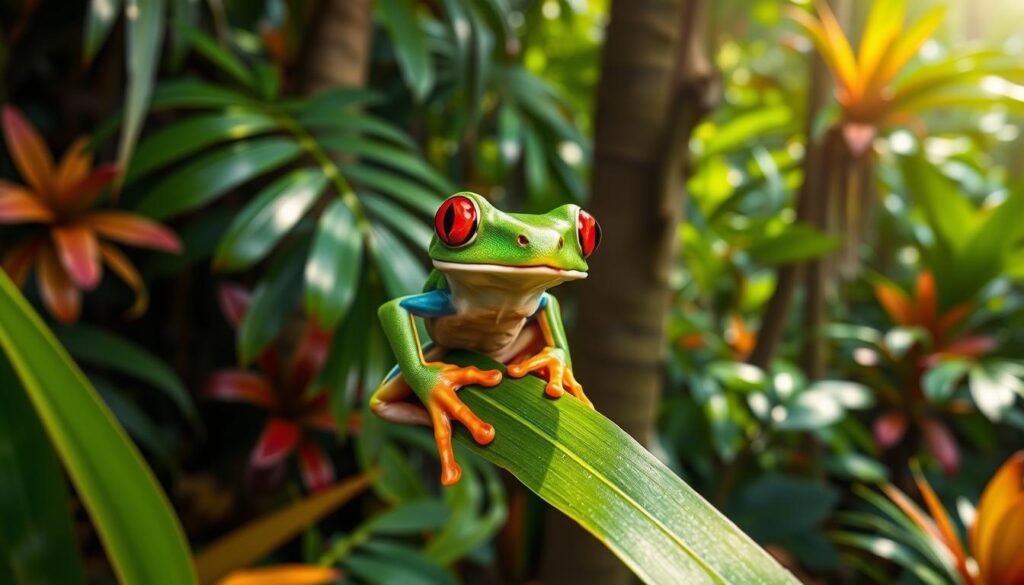
The red eyes of the red-eyed tree frog, known as Agalychnis callidryas, are more than just a striking feature. They are a key adaptation for survival in the rainforest. These bulging red eyes act as a defense mechanism.
The Science Behind Their Scarlet Peepers
The red color of the frog’s eyes is a form of startle coloration. When threatened, the frog opens its eyes wide, showing off the bright scarlet. This can startle or confuse predators, giving the frog a chance to escape.
Predator Deterrent Mechanism
The frog’s red eyes may also deter predators. The bright colors can create an afterimage in a predator’s eyes. This makes it hard for them to track the frog as it jumps away. This helps the frog avoid becoming prey for snakes, birds, and small mammals.
The evolution of the red-eyed tree frog’s appearance is crucial for its survival. Its bulging red eyes serve as a startling display and a predator deterrent. This shows the amazing adaptability of nature.
Habitat and Geographic Distribution
The red-eyed tree frog is a vibrant amphibian found in the tropical lowlands, central america, and northern south america. It loves the lush rainforest canopy from southern Mexico to Panama and northern Colombia.
These frogs need forests and water close by for breeding. They live high in the canopy of both lowland and mountain forests. Females can grow up to 77 mm, and males up to 59 mm.
Interestingly, the number of bars on their flanks grows from north to south. In Mexico, it’s a mean of 5.0 bars, and in Panama, it’s 9.0 bars. Young frogs in Panama can change color, looking green by day and purplish or reddish-brown at night.
Red-eyed tree frogs prefer a warm, humid environment. Daytime temperatures are 24°C to 29°C, and nighttime temperatures are 19°C to 25°C. They thrive in humidity levels of 80-100% and can live up to 1,250 meters high.
Despite facing threats like deforestation and the pet trade, they are not currently endangered. Thanks to their large numbers and adaptability, they are listed as Least Concern on the IUCN Red List.
Remarkable Defense Mechanisms and Adaptations
The red-eyed tree frog, known as Agalychnis callidryas, is famous for its amazing defense and adaptations. It lives in the lush rainforests of Central America. These features help it survive and thrive in its environment.
Startle Coloration Strategy
The frog’s most impressive defense is its deimatic behavior. When scared, it shows off its bright colors, including its red eyes. This startles and confuses predators.
Nocturnal Survival Techniques
The frog is nocturnal, meaning it’s active at night. It has big, bulging eyes for great night vision. This helps it hunt and move around in the dark.
It also has a nictitating membrane. This is a clear eyelid that protects its eyes. It keeps vision clear while keeping eyes safe.
By day, the frog uses camouflage to hide. It rests on leaf undersides, hiding its bright colors.
Thanks to these defense mechanisms and adaptations, the red-eyed tree frog thrives. It survives and remains a key part of the rainforest ecosystem.
Dietary Habits and Hunting Behavior
The red-eyed tree frog eats insects like crickets, flies, moths, and small frogs. It hunts at night, using its sharp eyes to find food in the dark rainforest.
It catches its prey with a long, sticky tongue from a high perch. The frog waits patiently for insects to come close. Then, it strikes fast to grab and eat its meal.
| Prey | Frequency |
|---|---|
| Crickets | Frequent |
| Flies | Frequent |
| Moths | Occasional |
| Smaller Frogs | Rare |
The red-eyed tree frog is great at hunting because it can hide in the leaves. Its varied diet helps it survive well in the rainforest.
Reproduction and Life Cycle
The red-eyed tree frog, Agalychnis callidryas, has captivating mating rituals and a fascinating life cycle. During mating season, males attract females by shaking leaves and making a unique call. After mating, the female lays about 40 eggs on leaves overhanging water.
Mating Rituals
The mating of red-eyed tree frogs is a natural wonder. Males show off by shaking leaves and making sounds to attract females. These displays help males show their best qualities, leading to successful mating.
Egg Development and Tadpole Stage
After the female lays her eggs, development starts. The eggs hatch in about 6-7 days, and the tadpoles fall into the water. These tadpoles then go through a long transformation, becoming young froglets after weeks or months.
The life cycle of the red-eyed tree frog is a marvel of nature. From the dramatic mating rituals to the amazing transformation into froglets, it shows the beauty of tropical rainforests.
Survival Challenges in Modern Times
Red-eyed tree frogs, known for their bright colors, face big challenges today. Their homes, the rainforests, are being cut down for farming and wood. This is a big problem because these frogs need the rainforests to live.
Climate change is also hurting these frogs. Weather changes and temperature shifts mess with their breeding. This can harm their homes and way of life. Diseases like ranavirus are another danger, threatening their survival.
The pet trade is also a problem. Even with rules, people still want these frogs. This demand can hurt wild populations and damage their homes.
| Threat | Impact |
|---|---|
| Habitat Loss | Deforestation for agriculture and timber development reduces the available habitat for red-eyed tree frogs, forcing them to adapt or face local extinction. |
| Climate Change | Changing weather patterns and temperature fluctuations disrupt the red-eyed tree frog’s sensitive breeding cycles and alter the delicate balance of their natural habitat. |
| Disease | The spread of diseases like ranavirus poses a significant threat to red-eyed tree frog populations, further compromising their survival. |
| Pet Trade | The high demand for red-eyed tree frogs in the international pet trade puts pressure on wild populations, leading to unsustainable collection and habitat degradation. |
Despite these challenges, efforts to save these frogs are underway. In places like Belize, work is being done to protect their homes. By tackling habitat loss, climate change, and the pet trade, we can help these frogs thrive. This will also keep the rainforests beautiful for future generations.
Conservation Status and Protection Efforts
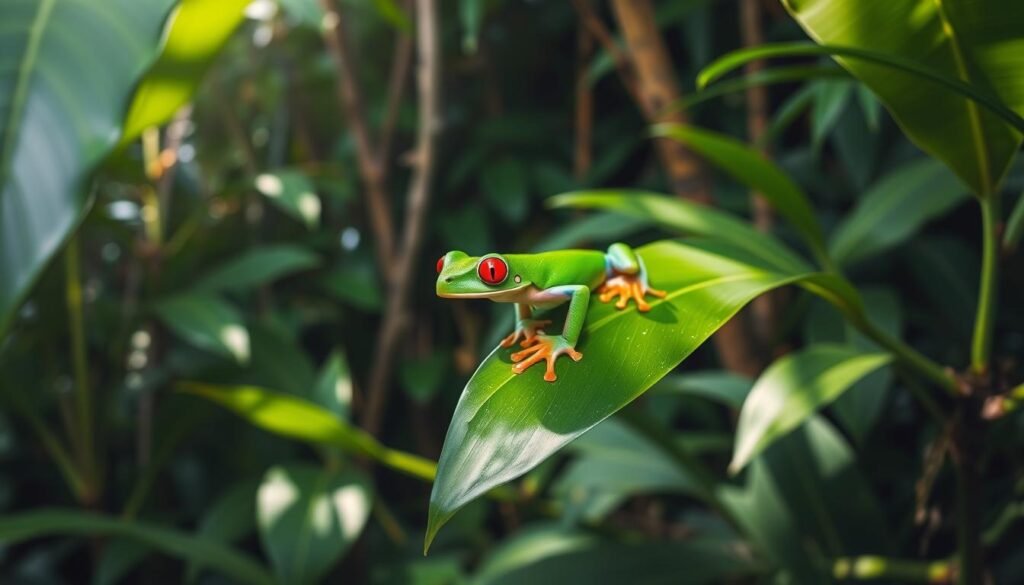
The red-eyed tree frog is known for its bright colors and striking look. It is listed as Least Concern on the IUCN Red List. But, it has been under the Convention on International Trade in Endangered Species of Wild Fauna and Flora (CITES) since 2008. This shows we need to watch its international trade closely.
Efforts to save the red-eyed tree frog include creating protected areas. Places like the Laguna Grande Reserve in Central America are perfect for them. This frog is a symbol of rainforest conservation, helping us understand why these areas are so important.
Even though it’s not in danger, the red-eyed tree frog still faces many threats. These include losing its home, pollution, and deadly fungal infections. Organizations worldwide are working hard to protect it and its rainforest home. They want to make sure this amazing creature continues to amaze and inspire people for years to come.
Thanks to teamwork and detailed plans, like the Amphibian Conservation Action Plan, the red-eyed tree frog’s future looks bright. By protecting its home and teaching people about biodiversity, we can help this frog thrive in the rainforests it loves.
Behavioral Patterns and Daily Activities
The red-eyed tree frog is a fascinating amphibian known for its unique lifestyle and captivating behavior. These vibrant creatures are mostly active at night. They hunt for insects and socialize when it’s dark.
By day, they sleep on the underside of leaves, hiding their bright colors from predators. Their toe pads help them climb and cling to the forest canopy. This makes them skilled at navigating the trees.
At night, they hunt for small invertebrates like crickets and roaches. Their nighttime hunting is crucial for survival. Darkness protects them from predators.
During breeding season, male red-eyed tree frogs show off to attract mates. They call out, bob their heads, and use visual cues. This behavior is key to their life cycle, ensuring their population grows.
| Behavior | Description |
|---|---|
| Arboreal Lifestyle | Red-eyed tree frogs are adept climbers, using their specialized toe pads to move through the forest canopy with ease. |
| Sleep Patterns | During the day, these frogs sleep on the underside of leaves, concealing their bright colors from potential predators. |
| Nocturnal Activity | At night, red-eyed tree frogs become active, hunting for insects and engaging in social behaviors. |
| Breeding Behavior | During the breeding season, males call and display to attract mates, a critical part of the species’ life cycle. |
The red-eyed tree frog’s captivating behavior and daily activities show its remarkable rainforest adaptations. Understanding these traits helps us appreciate the balance of life in these lush ecosystems.
Conclusion
The red-eyed tree frog is a symbol of rainforest biodiversity. Its striking look and special traits make it stand out. It shows us why we must protect rainforests and their many species.
This frog is not endangered now, but its situation warns us about rainforest issues. Scientists and conservationists work hard to save it and its home. Their efforts show the natural world’s strength and weakness.
Studying the red-eyed tree frog teaches us about the rainforest icon‘s complex life. Saving this frog and its home helps us keep our natural heritage safe. It also helps maintain the balance of the rainforest ecosystem.
FAQ
What is the scientific classification of the red-eyed tree frog?
The red-eyed tree frog (Agalychnis callidryas) is in the class Amphibia. It’s in the order Anura and family Phyllomedusidae.
What are the physical characteristics of the red-eyed tree frog?
The red-eyed tree frog is 1.5 to 2.75 inches long. Females are a bit bigger than males. It has a green body, big red eyes, orange feet, and blue-and-yellow flanks.
Where is the natural distribution range of the red-eyed tree frog?
It lives from southern Mexico to northern Colombia. It’s found in tropical forests near water.
What is the purpose of the red-eyed tree frog’s striking coloration?
Its bright colors help it defend itself. The red eyes might startle predators.
How do red-eyed tree frogs defend themselves?
They use color to scare off predators. They also hide their colors during the day. And they have a special membrane to protect their eyes.
What do red-eyed tree frogs eat?
They eat insects like crickets and flies. Sometimes, they eat smaller frogs too.
How do red-eyed tree frogs reproduce?
Males attract females by shaking leaves and calling. Females lay eggs on leaves over water. The tadpoles hatch and grow in the water.
What are the main threats to the red-eyed tree frog?
Threats include habitat loss, climate change, diseases, and the pet trade.
What is the conservation status of the red-eyed tree frog?
It’s listed as Least Concern but is regulated by CITES. Efforts include protected areas and raising awareness.

